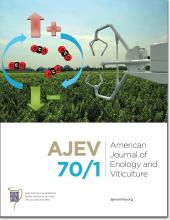Ver ítem
- xmlui.general.dspace_homeCentros Regionales y EEAsCentro Regional Mendoza - San JuanEEA MendozaArtículos científicosxmlui.ArtifactBrowser.ItemViewer.trail
- Inicio
- Centros Regionales y EEAs
- Centro Regional Mendoza - San Juan
- EEA Mendoza
- Artículos científicos
- Ver ítem
Chemical and sensory effects of cold soak, whole cluster fermentation, and stem additions in Pinot noir wines
Resumen
Pinot noir wines were produced over two consecutive vintages using four and six different winemaking techniques in 2014 and 2015, respectively. In addition to control wines, the separate and combined effect of cold soak (CS) and additions of 20% of whole clusters (WC) and 3% stems (S) were investigated for their impact on phenolics, color, volatile and sensory composition of the resulting wines. The basic chemistry of the wines was marginally, if at all
[ver mas...]
Pinot noir wines were produced over two consecutive vintages using four and six different winemaking techniques in 2014 and 2015, respectively. In addition to control wines, the separate and combined effect of cold soak (CS) and additions of 20% of whole clusters (WC) and 3% stems (S) were investigated for their impact on phenolics, color, volatile and sensory composition of the resulting wines. The basic chemistry of the wines was marginally, if at all affected by CS, WC or S treatments. For the cooler 2014 vintage, CS increased tannin extraction by 37% whereas for the warmer 2015 vintage, CS had no effect on tannin extraction relative to control wines. Addition of stems increased tannin extraction by 60%. Overall for both vintages, CS decreased anthocyanin extraction and color intensity. β-damascenone absolute concentration and Odor Activity Value were higher in control and control + WC wines than in CS wines, suggesting that the former wines were fruitier than CS wines. Sensory descriptive analysis of the wines indicated that control wines of the 2014 vintage were the least saturated in color, whereas CS + WC wines were the most saturated. However, the opposite was found in 2015 whereby CS decreased color saturation. Control wines were fruitier whereas WC wines were less fruity but higher in floral and bitter almond aromas. This aroma shift was most likely due to the influence of the added stems. Whole clusters and stem additions had a moderate effect of on the diversity of aromas and a larger, enhancing effect on bitter taste and astrigency within the sensory profile of these Pinot noir wines.
[Cerrar]

Autor
Casassa, Luis Federico;
Sari, Santiago Eduardo;
Bolcato, Esteban Augusto;
Diaz Sambueza, Alejandra Mariela;
Catania, Anibal Alejandro;
Fanzone, Martín Leandro;
Raco, Fernando;
Barda, Nora;
Fuente
American journal of enology and viticulture 70 (1) : 19-33. (January 2019)
Fecha
2019-01
Editorial
American Society for Enology and Viticulture
ISSN
0002-9254
Formato
pdf
Tipo de documento
artículo
Palabras Claves
Derechos de acceso
Restringido
 Excepto donde se diga explicitamente, este item se publica bajo la siguiente descripción: Creative Commons Attribution-NonCommercial-ShareAlike 2.5 Unported (CC BY-NC-SA 2.5)
Excepto donde se diga explicitamente, este item se publica bajo la siguiente descripción: Creative Commons Attribution-NonCommercial-ShareAlike 2.5 Unported (CC BY-NC-SA 2.5)

